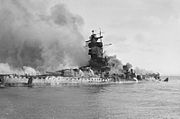Operation Pelikan
Appearance
| Operation Pelikan | |
|---|---|
| Part of the American Theater of World War II | |
 A schematic of the Panama Canal, illustrating the sequence of locks and passages. | |
| Location | |
| Planned by | |
| Objective | Sabotage of the Panama Canal |
| Date | 1943 |
| Outcome | Aborted |
Operation Pelikan[1] (German: Unternehmen Pelikan), also known as Projekt 14, was a German plan for crippling the Panama Canal during World War II. In the fall of 1943 the Wehrmacht had completed preparations to haul two Ju-87 Stukas with folding wings on two U-boats to an unnamed Colombian island near the coast of Panama, reassemble the planes, arm them with "special bombs", and then send them to attack the Gatun Dam. After completing the mission, the pilots would fly to a neutral country and seek internment. However, Germany called off the plan, for unknown reasons, at the last minute.
Most of these types of plans involved acts of sabotage using agents in place and/or landed by U-boat.[citation needed]
See also
References
This article needs additional citations for verification. (August 2007) |
- ^ Grayson, William C. (2005). Delaware's Ghost Towers: The Coast Artillery's Forgotten Last Stand During the Darkest Days of World War II. AuthorHouse. ISBN 1420847147.
{{cite book}}: line feed character in|title=at position 26 (help) - ^ Ladislas Farago's The Game of the Foxes: The Untold Story of German Espionage in the United States and Great Britain During World War II has a brief mention on the plan.
- ^ They Came to Destroy America: The FBI Goes to War Against Nazi Spies & Saboteurs During World War II (2003) by Stan Cohen, Don DeNevi, and Richard Gray

